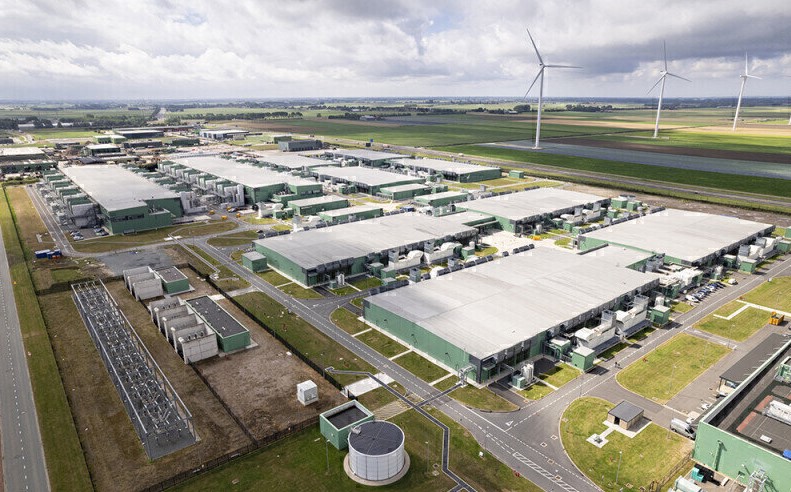
By Shafik Hebous, and Nate Vernon-Lin*
What do crypto assets and artificial intelligence have in common? Both are power hungry.
Because of the electricity used by high-powered equipment to “mine” crypto assets, one Bitcoin transaction requires roughly the same amount of electricity as the average person in Ghana or Pakistan consumes in three years. ChatGPT queries require 10 times more electricity than a Google search, due to the electricity consumed by AI data centres.
As the Chart of the Week shows, crypto mining and data centres together accounted for 2 percent of world electricity demand in 2022. And that share is likely to climb to 3.5 percent in three years, according to our estimates based on projections from the International Energy Agency. That would be equivalent to current consumption of Japan, the world’s fifth largest electricity user.
The climate impact of these activities—irrespective of their social and economic benefits—is cause for concern. A recent IMF working paper found that crypto mining could generate 0.7 percent of global carbon dioxide emissions by 2027. Extending the analysis to data centres (based on IEA estimates), means their carbon emissions could reach 450 million tons by 2027, or 1.2 percent of the world total.
The tax system is one way to steer companies toward curbing emissions. According to IMF estimates, a direct tax of $0.047 per kilowatt hour would drive the crypto mining industry to curb its emissions in line with global goals. If considering air pollution’s impact on local health as well, that tax rate would rise to $0.089, translating into an 85 percent increase in average electricity price for miners. Such a levy would raise annual government revenue of $5.2 billion globally and reduce annual emissions by 100 million tons (around Belgium’s current emissions).
For data centres, a targeted tax on their electricity use would need to be set at $0.032 per kilowatt hour, or $0.052 including air pollution costs. It is slightly lower than for crypto because data centres tend to be in locations with greener electricity. This could raise as much as $18 billion annually.
The situation today is the opposite: many data centres and crypto miners enjoy generous tax exemptions and incentives on income, consumption, and property. Considering the environmental damage, the lack of significant employment, and pressures on the electrical grid (possibly raising prices for households and reducing demand for the use of other low emissions goods, such as electric vehicles), the net benefits of these special tax regimes are unclear at best.
Policy incentives
On the flip side, AI applications could lead to smarter and more efficient power use, which some have posited could help ease electricity demand. The right policies can still incentivize developing AI applications with positive societal spillovers while addressing the environmental damage.
For policymakers, a broad carbon price coordinated across countries would be the best way to curb emissions, because it would encourage reduced fossil-fuel consumption, cleaner power sources, and improved energy efficiency. To limit global warming to 2 degrees, countries would need to introduce additional measures equivalent to a carbon price rising to $85 per ton by 2030.
In the absence of a global carbon price, targeted measures could encourage crypto miners and data centres to use more energy-efficient equipment and may even motivate the adoption of less energy intensive crypto mining. Complementing electricity taxes with credits for zero-emission, bilateral power purchase agreements, and potentially renewable energy certificates would also help.
Cross-border coordination also remains important, as stricter measures in one location could encourage relocation to jurisdictions with lower standards.
As the window of opportunity for containing rising temperatures rapidly closes, expanding renewable energy sources and adopting an appropriate carbon price are urgently needed. In the interim, targeted measures, including taxation, can help mitigate increasing emissions from crypto mining and data centres.
Shafik Hebous is a Deputy Division Chief in the IMF’s Fiscal Affairs Department of the IMF. Nate Vernon-Lin is an Economist in the Climate Policy Division of the Fiscal Affairs Department. This article was originally posted here.
2 Comments
Hands up anyone who regularly uses AI tools - what's your application?
In the definition of AI tools available to date (which even the most advanced operate at an exceedingly low level), I use the most are test, bot (for repeated tasks), generation and detection tools. Although in vehicles the drive assist is dangerous on nz roads; constantly veering into culverts on SH, trying to go into trucks, cutting speed when overtaking said trucks in passing lanes.
Everyone now needs to be more aware of AI faults/features, the design issues etc even if has just been put into their search engine or workflow (like ACC insane use case for it).


We welcome your comments below. If you are not already registered, please register to comment.
Remember we welcome robust, respectful and insightful debate. We don't welcome abusive or defamatory comments and will de-register those repeatedly making such comments. Our current comment policy is here.